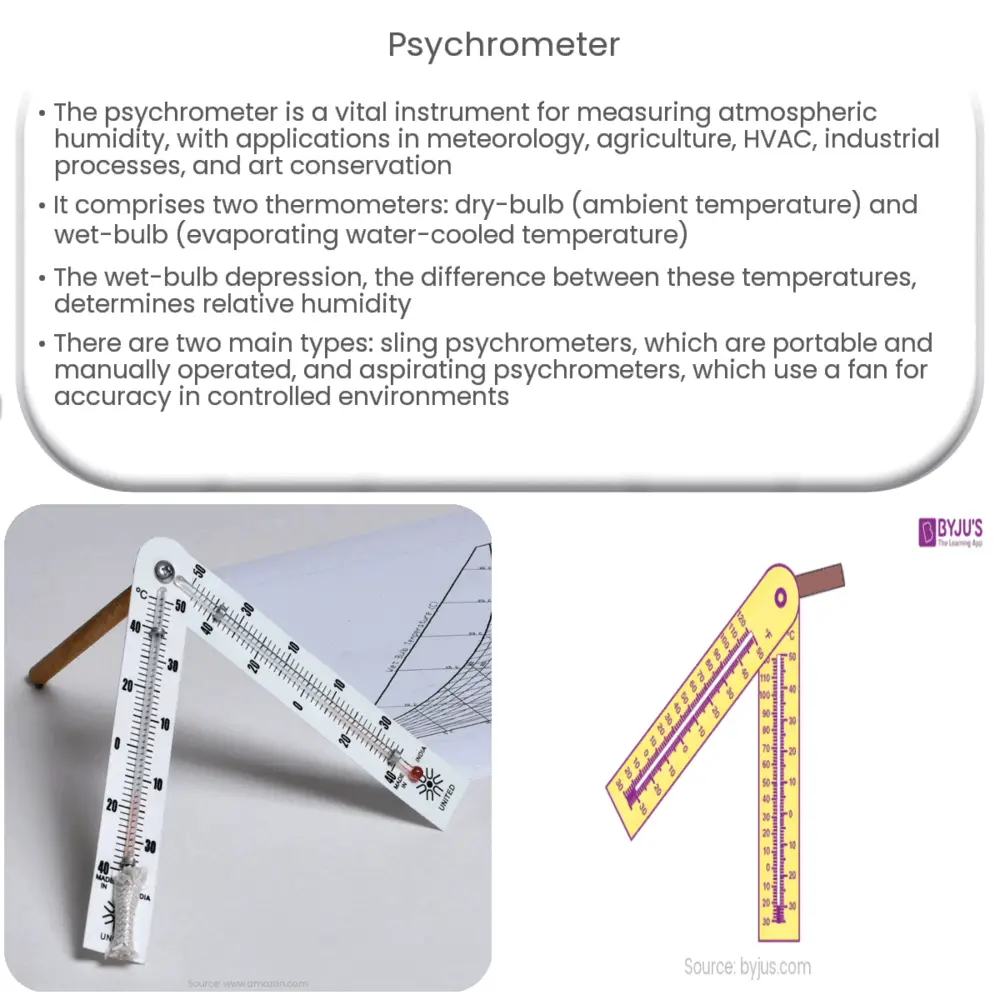A psychrometer is a meteorological tool used to measure humidity levels, with applications in agriculture, HVAC, and weather forecasting.

Understanding the Psychrometer: An Essential Tool in Meteorology
Introduction
A psychrometer is an invaluable instrument used in meteorology and various other fields to measure humidity in the atmosphere. Understanding how a psychrometer works, its types, and applications is essential for anyone working in weather forecasting, HVAC systems, or agricultural research. In this article, we will delve into the mechanics of the psychrometer, explore the different types of psychrometers, and discuss their practical applications.
How a Psychrometer Works
A psychrometer consists of two thermometers: a dry-bulb thermometer and a wet-bulb thermometer. The dry-bulb thermometer measures the ambient air temperature, while the wet-bulb thermometer has a moistened wick or cloth covering the bulb to measure the temperature of air that has been cooled by evaporating water. When air flows over the wet-bulb thermometer, the water on the wick evaporates, causing the temperature to drop. The difference between the dry-bulb and wet-bulb temperatures, known as the wet-bulb depression, is used to determine the relative humidity of the air.
To calculate the relative humidity, the dry-bulb and wet-bulb temperatures are compared with psychrometric charts or formulas, which display the relationship between temperature, humidity, and the moisture content of the air. As the wet-bulb depression increases, the relative humidity decreases, indicating that the air can hold more moisture before reaching saturation.
Types of Psychrometers
There are two main types of psychrometers: sling psychrometers and aspirating psychrometers. Each has its own set of advantages and disadvantages.
Sling Psychrometer
A sling psychrometer consists of a dry-bulb and wet-bulb thermometer mounted on a handle, which can be swung in the air to create airflow over the wet-bulb thermometer. The rapid evaporation of the water from the wick cools the wet-bulb thermometer, providing an accurate measurement of the wet-bulb temperature. Sling psychrometers are portable and require no external power source, making them ideal for field measurements. However, they can be less accurate than aspirating psychrometers due to potential inconsistencies in airflow and the need for the user to swing the device.
Aspirating Psychrometer
An aspirating psychrometer uses a fan to create a consistent airflow over the wet-bulb thermometer, ensuring a more accurate and consistent measurement of wet-bulb temperature. These devices are typically more expensive and require an external power source, but their improved accuracy and consistency make them suitable for use in laboratories and other controlled environments.
Applications of Psychrometers
Psychrometers are used in a variety of industries and fields due to their ability to accurately measure humidity. Some common applications include:
Meteorology and Weather Forecasting
Humidity is a critical component of weather systems, as it affects precipitation, cloud formation, and air quality. Psychrometers are frequently used by meteorologists to gather data on humidity levels, which is then incorporated into weather models and forecasts.
Agriculture and Horticulture
Understanding humidity levels is essential for farmers and horticulturists, as it impacts crop growth, plant health, and pest control. Psychrometers are used to monitor humidity in greenhouses, fields, and other growing environments, enabling farmers to make informed decisions about irrigation, ventilation, and other management practices.
Heating, Ventilation, and Air Conditioning (HVAC)
Psychrometers play a crucial role in HVAC system design and maintenance. By measuring humidity, HVAC professionals can assess the efficiency of air conditioning systems, identify potential issues, and ensure that indoor environments remain comfortable and healthy.
Industrial Processes
Many industrial processes, such as drying, cooling, and chemical manufacturing, are sensitive to humidity levels. Psychrometers are used to monitor and control these processes, ensuring that they operate efficiently and safely.
Art Conservation and Museum Environments
Artworks and historical artifacts can be damaged by excessive humidity or rapid fluctuations in humidity levels. Psychrometers are used in museums and conservation facilities to monitor and maintain appropriate environmental conditions, preserving priceless works of art and cultural heritage for future generations.
Conclusion
The psychrometer is an essential tool for measuring humidity in a range of applications, from weather forecasting to art conservation. By understanding the principles behind its operation and the different types of psychrometers available, professionals in various fields can make informed decisions about the best instrument for their needs. With accurate humidity measurements, it becomes possible to optimize processes, improve safety, and maintain a healthy environment in numerous settings.

